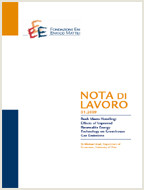Measures, Drivers and Effects of Green Employment: Evidence from US Local Labor Markets, 2006-2014

10.07.2016
J23, O33, Q52, R23
Green Employment, Local Labor Markets, Environmental Regulation, Environmental Technologies, Local Multipliers
Mitigation, Innovation and Transformation Pathways
Massimo Tavoni
This paper explores the nature and the key empirical regularities of green employment in US local labor markets between 2006 and 2014. We construct a new measure of green employment based on the task content of occupations. Descriptive analysis reveals the following: 1. the share of green employment oscillates between 2 and 3 percent, and its trend is strongly pro-cyclical; 2. green jobs yield a 4 percent wage premium; 3. despite moderate catching-up across areas, green jobs remain more geographically concentrated than similar non-green jobs; and 4. the top green areas are mostly high-tech. As regards the drivers, changes in environmental regulation are a secondary force compared to the local endowment of green knowledge and resilience in the face of the great recession. To assess the impact of moving to greener activities, we estimate that one additional green job is associated with 4.2 (2.4 in the crisis period) new jobs in non-tradable activities in the local economies.
***
Suggested citation: Vona, F., G. Marin, D. Consoli, (2016), ‘Measures, Drivers and Effects of Green Employment: Evidence from US Local Labor Markets, 2006-2014’, Nota di Lavoro 48.2016, Milan, Italy: Fondazione Eni Enrico Mattei
